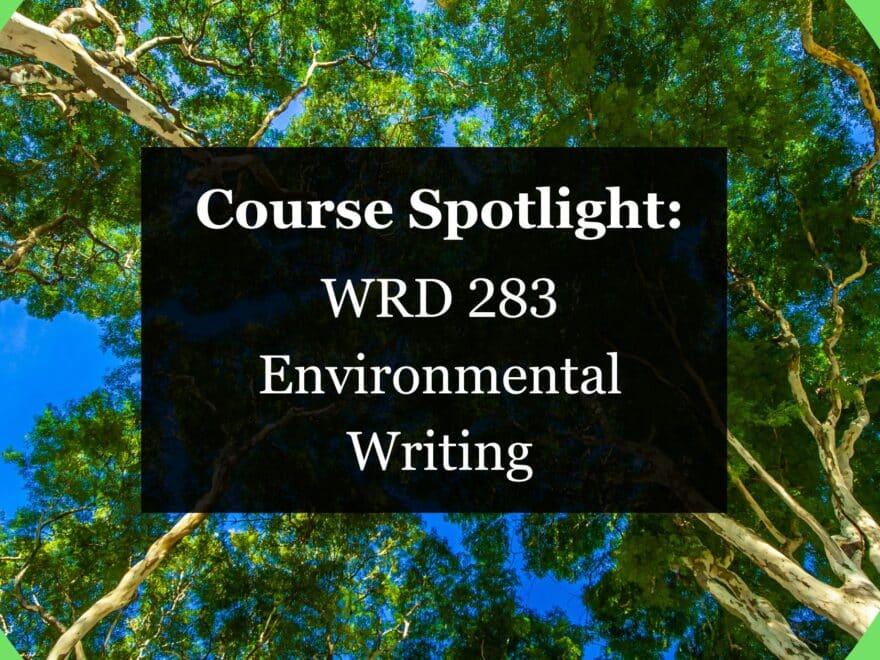Scheduled intentionally in Spring Quarter as changes in the environment become more easily perceptible, WRD 283 Environmental Writing, taught by Dr. Jason Kalin, offers more than just Social, Cultural, Behavioral Inquiry (SCBI) credit. It offers a chance to grow along with nature into new perspectives.
What is Environmental Writing?
In this course, environmental writing is writing about the environment and nature, but from the rhetorical perspective that the environment and nature are not just something “out there” or external to humans. The class tries to impart the perspective that we are not separate from our environment. Rather, we are nature and nature is us.
What are the course goals and learning outcomes?
By engaging in theoretical perspectives of environmental rhetoric and philosophy, WRD 283 Environmental Writing offers students a fundamental shift in perspective that nature is not “out there” but rather in and around all of us. Concepts like deep ecology, or the sense that we are implicated in nature and that everything is connected, teach that changes in one event can have rippling effects, for better or for worse.
One example of the rippling effects the course tackles is environmental justice issues like sacrifice zones (or areas of certain cities or regions that are decimated as industrial areas) especially in Chicago like Little Village. This human created environmental change is found by rooting inquiry in the Anthropocene—the geological era marked by human involvement.
Another phenomenon relevant to us here in Chicago is that of nature blindness, where we overlook and overgeneralize the environment—for instance seeing plants as the general “plant” rather than a particular species. Dr. Kalin aims to change nature blindness by having students build relationships with their environment. By centering the course on phenology, or the study of cyclical changes emerging from the seasons, students will begin to notice when trees are sprouting, for instance. Dr. Kalin hopes this will increase the students’ awareness, engagement, curiosity, and wonder about the world around them.
What is Dr. Kalin’s inspiration for teaching WRD 283 Environmental Writing?
Having been interested in environmental rhetorics for many years, Dr. Kalin had seen WRD 283 on the course list since 2012 and wanted to figure out how to teach it. In 2018, when he came across a book called Ground Truth: A Guide to Tracking Climate Change at Home by Mark Hineline, he learned about phenology. As the central text of the course, Ground Truth shows how students can actually see climate change at home, making it concrete and perceptible.
One example of a phenological observation Dr. Kalin shares:

A common lilac blossoming
Common Lilac
Syringa vulgaris
Lincoln Park, Chicago
Further, Dr. Kalin identified that people—especially young people—have strong environmental emotions marked by sadness, depression, despair, and grief that nothing can be done to stop climate change. He wants to acknowledge that grief, but also work through it into wonder, happiness, and joy at the environment around us. Ultimately, by attending to both negative and positive emotions at once, we can become better co-inhabitants of the earth.
How is the course structured?
The first couple weeks of the course, students are introduced to phenology by reading Ground Truth as the backbone of their work. Then, the class shifts into topics like environmental philosophy, ecological thinking, unraveling the urban/nature dichotomies. Finally, the course moves on to discuss the Gaia hypothesis, environmental justice, indigenous ecological knowledge and how that can inform our understanding of nature, as well as how to pay attention to birds, plants, insects, mammals, and nature all around us.
What major projects will students complete?
The main project assigned to students in this course is to create what’s called a phenological trail. Early in the quarter, wherever students happen to be, they must create a trail through their regularly traveled paths where they will observe seasonal changes. Each week they will complete a phenological journal where they track changes and use their observations to learn more about the nature close to them.
Second, students will use their observations to do a deeper dive on one of the species they’re learning about and complete a field report. They will do more research to understand the history of the species and how it is impacted by global warming. Will the species disappear? Will it thrive? Students must determine what the research suggests.
Finally, students will come back to their phenological trail and do a second version where they track more changes with their heightened knowledge of the nature in and around them.
Who should take this course and why?
Dr. Kalin is certain: everyone should take this course. From students who are interested in the environment to students who have never really thought about it, this course is about understanding our place in the world and what we can do with it.
Final thoughts…
Enrolling in WRD 283 Environmental Writing means gaining an opportunity to learn environmental rhetoric and philosophy to develop a deeper understanding of the complex relationship between humans and nature. Develop connection with the world around you, awaken a sense of wonder and responsibility towards the planet, and use your new knowledge to go fight for meaningful change. Enroll in WRD 283 Environmental Writing for this Spring Quarter.
